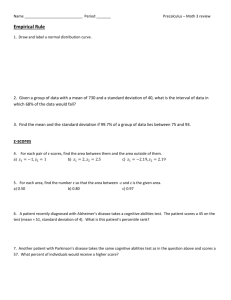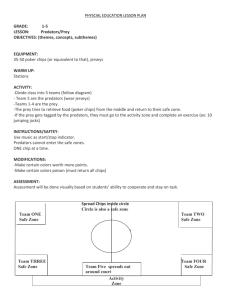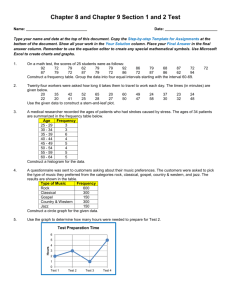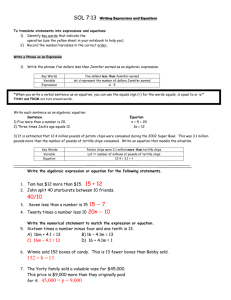Making Justifying Conclusions
advertisement
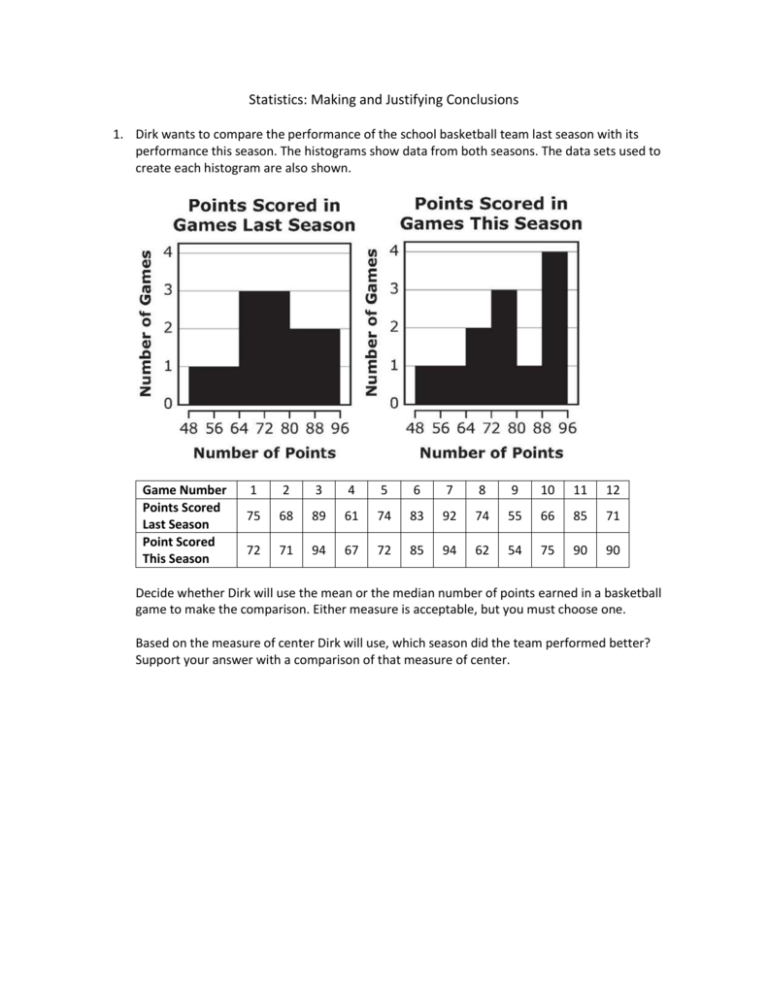
Statistics: Making and Justifying Conclusions 1. Dirk wants to compare the performance of the school basketball team last season with its performance this season. The histograms show data from both seasons. The data sets used to create each histogram are also shown. Game Number Points Scored Last Season Point Scored This Season 1 2 3 4 5 6 7 8 9 10 11 12 75 68 89 61 74 83 92 74 55 66 85 71 72 71 94 67 72 85 94 62 54 75 90 90 Decide whether Dirk will use the mean or the median number of points earned in a basketball game to make the comparison. Either measure is acceptable, but you must choose one. Based on the measure of center Dirk will use, which season did the team performed better? Support your answer with a comparison of that measure of center. 2. Lana wrote an article for the school newspaper about students attending college. There are over 1000 students in the senior class and over 4000 students at her school. Lana asked the first 40 seniors on a list of alphabetic names of seniors whether they intend to go to college, and 32 said yes. She reported in her article that 92% of students in the school intend to go to college. How could Lana improve the accuracy of the information she reported in her article? Select all that apply. A. B. C. D. E. 3. She could report that this only applies to seniors. She should check her arithmetic because she made a mistake computing the percent. She could ask the guidance counselors what percentage of the senior class went to college last year. There is no need to improve the accuracy of the information she reported because she did everything correctly. She could randomly select 40 students at the all-school assembly and ask them whether they intend to go to college. From a class containing 12 girls and 10 boys, three students are to be selected to serve on a school advisory panel. Here are four different methods of making the selection: Method 1: Select the first three names on the alphabetized class roll. Method 2: Select the first three students who volunteer. Method 3: Place the names of the 22 students in a hat, mix them thoroughly, then select three names from the mix. Method 4: Select the first three students who show up for class tomorrow. Part A Which is the best sampling method, among these four, if you want the school panel to represent a fair and representative view of the opinions of your class? Part B Explain a weakness of one of the methods you did not select as the best. 4. Each of 40 students in a classroom is given a bag with a total of 10 chips, some red and some white. Students cannot see into the bags. The students will play a game in which a round consists of each student removing one chip from the bag without looking. If the chip is red, the student remains in the game. If it is white, the student is out of the game. The chip is then replaced into the bag and those students still in the game continue with another round, until only one student is left. Part A Suppose each bag has 6 red chips and 4 white chips. Fill in the table below to indicate how many students you would expect to continue in the game after each round. It is ok to have a non-integer expected number of students in any round. 6 red chips and 4 white chips Number of students Round still in game 0 1 2 3 4 5 6 7 Part B Develop a table similar to the one made in Part A based upon the bag containing 5 red chips and 5 white chips. Make a second table based upon the bag containing 7 red chips and 3 white chips. 5 red chips and 5 white chips Round Number of students still in game 0 7 red chips and 3 white chips Round Number of students still in game 0 1 1 2 2 3 3 4 4 5 5 6 6 7 7 Part C The following represent the actual results from the classroom. Round 0 1 2 3 4 5 6 7 Number of students still in game 40 26 17 9 6 4 2 1 Based on the actual results and the 3 models developed, do you believe that each bag contained 5, 6, or 7 red chips? Explain why. 5. A student interested in comparing the effect of different types of music on short-term memory conducted the following study: The 80 volunteers were randomly assigned to one of two groups. The first group was given five minutes to memorize a list of words while listening to rap music. The second group was given the same task while listening to classical music. The number of words correctly recalled by each individual was then measured and the results for the two groups were compared. Part A Is this an experiment or an observational study? Justify your answer. Part B Explain why it is important that the subjects were randomly assigned to the two groups (rap and classical music). 6. You want to evaluate whether the traditional value of 98.6° F is correct for a typical body temperature for healthy adults. You plan to estimate mean body temperatures by recording the temperatures of the people in a random sample of 10 healthy adults and calculating the sample mean. Your research suggests that the body temperature for healthy adults follows a normal distribution with mean 98.6 and standard deviation of 0.7. Here are the body temperatures for one of your random sample of 10 healthy adults: 97.73 98.76 98.27 99.05 98.47 98.49 98.97 98.68 99.27 99.25 Part A Does the random sample support, disprove, or neither a mean of 98.6 and a standard deviation of 0.7 for healthy adults? Explain. Part B Below is a dot plot of the calculated mean body temperatures for 100 different random samples of size 10 from a population of healthy adults. Does the data in the dot plot support, disprove, or neither a mean of 98.6 and a standard deviation of 0.7 for healthy adults? Explain. Teacher Material S-IC.A Understand and evaluate random processes underlying statistical experiments S-IC.B Make inferences and justify conclusions from sample surveys, experiments, and observational studies Question Claim 1 4 2 3 4 3 Key/Suggested Rubric 1 point: Student compares the mean (~74.4 for last season and ~77.2 for this season) or median (74 for last season and 73.5 for this season) and determines which season had the better performance based on a correct comparison. NOTE: Allow students to state and support that performance wasn’t better or worse (likely based on the medians being so close together) last season than this season. 1 point: Selects A, B, and E. 2 points: Indicates Method 3 AND describes a weakness of Method 1, 2, OR 4. Example: You shouldn’t take the first three names on an alphabetized list because then not everyone has a chance to be on the panel. 1 point: Indicates Method 3 OR describes a weakness of Method 1, 2, OR 4. 4 4 3 points: Provides table in Part A with reasonable values AND provides tables in Part B with reasonable values AND states the actual results best match 6 red and 4 white OR 7 red and 3 white and provides justification. 2 points: Provides two of the three: Provides table in Part A with reasonable values, provides tables in Part B with reasonable values, states the actual results best match 6 red and 4 white OR 7 red and 3 white and provides justification. 1 point: Provides table in Part A with reasonable values OR provides tables in Part B with reasonable values OR states the actual results best match 6 red and 4 white OR 7 red and 3 white and provides justification. Part A: Round 0 1 2 3 4 5 6 7 Number of students still in game 40 24 14 to 15 8 to 9 4 to 6 2 to 4 1 to 3 0 to 2 Part B (5 red chips): Round 0 1 2 3 4 5 6 7 Number of students still in game 40 20 10 5 2 to 3 1 to 2 0 to 1 0 to 1 Part B (7 red chips): Round 0 1 2 3 4 5 6 7 Number of students still in game 40 28 19 to 20 13 to 14 9 to 10 6 to 7 4 to 5 2 to 4 5 3 6 3 2 points: States the study is an experiment and provides a justification AND explains why random assignment is important. Example: This is an experiment because the subjects are told to listen to music selected for the experiment and observing the impact on memory. It is important to randomly assign subjects to the two groups to minimize the effect of individual’s memory ability on the results of the experiment and results are based on the music they listened to. 1 point: States the study is an experiment and provides a justification OR explains why random assignment is important. 2 points: Student provides reasoning and support for the sample of 10 temperatures AND the sample represented in the dot plot. Example 1: Yes, the data does disprove because the mean is 98.694, but the standard deviation is only 0.47. The same is for the dot plot because the standard deviation is maybe 0.22 or 0.3 because 68 of the 100 data points are between 98.3 and 98.82 with the center at 98.6. So either the mean isn’t 98.6 or the standard deviation isn’t 0.7; either disproves the statement. Example 2: The data set doesn’t disprove or prove the statement because there’s only 10 data points, and that’s not enough to prove or disprove the statement. In the dot plot, though, there are 1000 people which is better. With a mean of 98.6 and a standard deviation of 0.7, that means that about 68% of the data would be between 97.9 and 99.3, but the dot plot shows that all 100 of the samples are in that interval. So I think this disproves the statement because the standard deviation would be much less than 0.7. 1 point: Student provides reasoning and support for the sample of 10 temperatures OR the sample represented in the dot plot.

